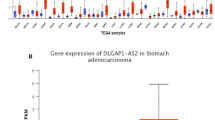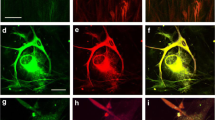Abstract
Glioblastoma multiforme (GBM) is the most common and aggressive brain tumor that affects older people. Although the current therapeutic approaches for GBM include surgical resection, radiotherapy, and chemotherapeutic agent temozolomide, the median survival of patients is 14.6 months because of its aggressiveness. Zoledronic acid (ZA) is a nitrogen-containing bisphosphonate that exhibited anticancer activity in different cancers. The purpose of this study was to assess the potential effect of ZA in distinct signal transduction pathways in U87-MG cells. In this study, experiments performed on U87-MG cell line (Human glioblastoma-astrocytoma, epithelial-like cell line) which is an in vitro model of human glioblastoma cells to examine the cytotoxic and apoptotic effects of ZA. IC50 dose of ZA, 25 μM, applied on U87-MG cells during 72 h. ApoDIRECT In Situ DNA Fragmentation Assay was used to investigate apoptosis of U87MG cells. The quantitative reverse transcription polymerase chain reaction (qRT-PCR) (LightCycler480 System) was carried out for 48 gene expression like NF-κB, Toll-like receptors, cytokines, and inteferons. Our results indicated that ZA (IC50 dose) increased apoptosis 1.27-fold in U87MG cells according to control cells. According to qRT-PCR data, expression levels of the endoplasmic reticulum-nuclei-1 (ERN1), Toll-like receptor 2 (TLR2), and human IFN regulatory factor 5 (IRF5) tumor suppressor genes elevated 2.05-, 2.08-, and 2.3-fold by ZA, respectively, in U87MG cells. Our recent results indicated that ZA have a key role in GBM progression and might be considered as a potential agent in glioma treatment.


Similar content being viewed by others
References
Parsons DW, Jones S. X Zhang et al. An Integrated Genomic Analysis of Human Glioblastoma Multiforme: Science; 2008. doi:10.1126/science.1164382.
Bayin NS, Modrek AS, Placantonakis DG. Glioblastoma stem cells: molecular characteristics and therapeutic implications. World J Stem Cells. 2014;6(2):230–8.
Olar A, Aldape KD. Using the molecular classification of glioblastoma to inform personalized treatment. J Pathol. 2014;232:165–77.
Ramirez YP, Weatherbee JL, Wheelhouse RT, Ross AH. Glioblastoma multiforme therapy and mechanisms of resistance. Pharmaceuticals. 2013;6:1475–506.
Stupp R, Mason WP, van den Bent MJ, Weller M, Fisher B, Taphoorn MJ, et al. European organisation for research and treatment of cancer brain tumor and Radiotherapy groups, national cancer ınstitute of canada clinical trials group. Radiotherapy plus concomitant and adjuvant temozolomide for glioblastoma. NEngl J Med. 2005;352:987–96.
Okamoto S, Kawamura K, Quanhai L, Yamanaka M, Yang S, Fukamachi T, et al. Zoledronic acid produces antitumor effects on Mesothelioma through Apoptosis and S-phase arrest in p53-ındependent and Ras prenylation-ındependent manners. J Thorac Oncol. 2012;7:873–82.
Tamura T, Shomori K, Nakabayashi M, Fujii N, Ryoke K, Ito H. Zoledronic acid, a third-generation bisphosphonate, inhibits cellular growth and induces apoptosis in oral carcinoma cell lines. Oncol Rep. 2011;25:1139–43.
Verhulst A, Sun S, McKenna CE, D’Haese PC. Endocytotic uptake of Zoledronic acid by tubular cells may explain ıts renal effects in cancer patients receiving high doses of the compound. PLoS One. 2015;10(3):e0121861.
Morgan G, Lipton A. Antitumor effects and anticancer applications of bisphosphonates. Semin Oncol. 2010;37 Suppl 2:S30–40.
Gallo M, De Luca A, Lamura L, Normanno N. Zoledronic acid blocks the interaction between mesenchymal stem cells and breast cancer cells: implications for adjuvant therapy of breast cancer. Ann Oncol. 2012;23:597–604.
Stresing V, Daubine F, Benzaid I, Mönkkönen H, Clezardin P. Bisphosphonates in cancer therapy. Cancer Lett. 2007;257:16–35.
Gnant M, Clezardin P. Direct and indirect anticancer activity of bisphosphonates: a brief review of published literature. Cancer Treat Rev. 2012;38:407–15.
Coleman RE. Skeletal complications of malignancy. Cancer. 1997;80:1588–94.
Timothy MF. The role of Bisphosphonates in the management of patients that have cancer. Vet Clin Small Anim. 2007;37:1091–110.
Mahtani R, Jahanzeb M. Bisphosphonates as anticancer therapy for early breast cancer. Clinical Breast Cancer. 2010;10(5):359–66.
Neville-Webbe HL, Gnant M, Coleman RE. Potential anticancer properties of Bisphosphonates. Semin Oncol. 2010;37 Suppl 1:S53–65.
Singh T, Kaur V, Kumar M, Kaur P, Murthy RSR, Rawal RK. The critical role of bisphosphonates to target bone cancer metastasis: an overview. J Drug Target. 2015;23(1):1–15.
Chang J, Wang W, Zhang H, Hu Y, Yin Z. Bisphosphonates regulate cell proliferation, apoptosis and pro-osteoclastic expression in MG-63 human osteosarcoma cells. Oncol Lett. 2012;4:299–304.
Berenson JR. Antitumor effects of bisphosphonates: from the laboratory to the clinic. Curr Opin Support and Palliat Care. 2011;5:233–40.
Senaratne SG, Pirianov G, Mansi JL, Arnett TR, Colston KW. Bisphosphonates induce apoptosis in human breast cancer cell lines. Br J Cancer. 2000;82:1459–68.
Nakajima H, Magae J, Tsuruga M, Sakaguchi K, Fujiwara I, Mizuta M, et al. Induction of mitochondria-dependent apoptosis through the inhibition of mevalonate pathway in human breast cancer cells by YM529, a new third generation bisphosphonate. Cancer Lett. 2007;253:89–96.
Sewing L, Steinberg F, Schmidt H, Goke R. The bisphosphonate zoledronic acid inhibits the growth of HCT-116 colon carcinoma cells and induces tumor cell apoptosis. Apoptosis. 2008;13:782–9.
Coxon JP, Oades GM, Kirby RS, Colston KW. Zoledronic acid induces apoptosis and inhibits adhesion to mineralized matrix in prostate cancer cells via inhibition of protein prenylation. B J U Int. 2004;94:164–70.
Shipman CM, Croucher PI, Russell RG, Helfrich MH, Rogers MJ. The bisphosphonate incadronate (YM175) causes apoptosis of human myeloma cells in vitro by inhibiting the mevalonate pathway. Cancer Res. 1998;58:5294–7.
Green J, Lipton A. Anticancer properties of zoledronic acid. Cancer Investig. 2010;28:944–57.
Marra M, Abbruzzese A, Addeo R, Del Prete S, Tassone P, Tonini G, et al. Cutting the limits of aminobisphosphonates: new strategies for the potentiation of their anti-tumour effects. Curr Cancer Drug Targets. 2009;9:791–800.
Yuasa T, Kimura S, Ashihara E, Habuchi T, Maekawa T. Zoledronic acid - a multiplicity of anti-cancer action. Curr Med Chem. 2007;14:2126–35.
Di Salvatore M, Orlandi A, Bagala C, Quirino M, Cassano A, Astone A, et al. Anti- tumour and anti-angiogenetic effects of zoledronic acid on human non-small-cell lung cancer cell line. Cell Prolif. 2011;44:139–46.
Li YY, Chang JW, Chou WC, Liaw CC, Wang HM, Huang JS, et al. Zoledronic acid is unable to induce apoptosis, but slows tumor growth and prolongs survivalfor non-small-cell lung cancers. Lung Cancer. 2008;59:180–91.
Ibrahim T, Mercatali L, Sacanna E, Tesei A, Carloni S, Ulivi P, et al. Inhibition of breast cancer cell proliferation in repeated and non-repeated treatment with zoledronic acid. Cancer Cell Int. 2012;12(1):48.
Rachner TD, Singh SK, Schoppet M, Benad P, Bornhauser M, Ellenrieder V, et al. Zoledronic acid induces apoptosis and changes the TRAIL/OPG ratio in breast cancer cells. Cancer Lett. 2010;28(1):109–16.
Mani J, Vallo S, Barth K, Makarević J, Juengel E, Bartsch G, et al. Zoledronic acid influences growth, migration and invasive activity of prostate cancer cells in vitro. Prostate Cancer Prostatic Dis. 2012;15(3):250–5.
Kubista B, Trieb K, Sevelda F, Toma C, Arrich F, Heffeter P, et al. Anticancer effects of zoledronic acid against human osteosarcoma cells. J Orthop Res. 2006;24(6):1145–52.
Iguchi T, Miyakawa Y, Saito K, Nakabayashi C, Nakanishi M, Saya H, et al. Zoledronate-induced S phase arrest and apoptosis accompanied by DNA damage and activation of the ATM/Chk1/cdc25 pathway in human osteosarcoma cells. Int J Oncol. 2007;31(2):285–91.
Tassone P, Tagliaferri P, Viscomi C, Palmieri C, Caraglia M, D'Alessandro A, et al. Zoledronic acid induces antiproliferative and apoptotic effects in human pancreatic cancer cells in vitro. Br J Cancer. 2003;88(12):1971–8.
Romani AA, Desenzani S, Morganti MM, La Monica S, Borghetti AF, Soliani P. Zoledronic acid determines S-phase arrest but fails to induce apoptosis in cholangiocarcinoma cells. Biochem Pharmacol. 2009;78(2):133–41.
Koto K, Murata H, Kimura S, Horie N, Matsui T, Nishigaki Y, et al. Zoledronic acid inhibits proliferation of human fibrosarcoma cells with induction of apoptosis, and shows combined effects with other anticancer agent. Oncol Rep. 2010;24(1):233–9.
Liu SS, Wang XP, Li XB, Liang JY, Liu LL, Lu Y, et al. Zoledronic acid exerts antitumor effects in NB4 acute promyelocytic leukemia cells by inducing apoptosis and S phase arrest. Biomed Pharmacother. 2014;68(8):1031–6.
Karabulut B, Karaca B, Varol U, Muslu U, Cakar B, Atmaca H, et al. Enhancing cytotoxic and apoptotic effect in OVCAR-3 and MDAH-2774 cells with all-trans retinoic acid and zoledronic acid: a paradigm of synergistic molecular targeting treatment for ovarian cancer. J Exp Clin Cancer Res. 2010;29:102.
Porru M, Zappavigna S, Salzano G, Luce A, Stoppacciaro A, Balestrieri ML, et al. Medical treatment of orthotopic glioblastoma with transferrin-conjugated nanoparticles encapsulating zoledronic acid. Oncotarget. 2014;5(21):10446–59.
Hiraga T, Williams PJ, Ueda A, Tamura D, Yoneda T. Zoledronic acid inhibits visceral metastases in the 4T1/luc Mouse breast cancer model. Clin Cancer Res. 2004;10:4559–67.
Fromigue O, Lagneaux L, Body JJ. Bisphosphonates induce breast cancer cell death in vitro. J Bone Miner Res. 2000;15:2211–21.
Verdijk R, Franke HR, Wolbers F, Vermes I. Differential effects of bisphosphonates on breast cancer cell lines. Cancer Lett. 2007;246:308–12.
Cimini E, Piacentini P, Sacchi A, Gioia C, Leone S, Lauro GM, et al. Zoledronic acid enhances Vδ2 T-lymphocyte antitumor response to human glioma cell lines. Int J Immunopathol Pharmacol. 2011;24(1):139–48.
Nakazawa T, Nakamura M, Park YS, Motoyama Y, Hironaka Y, Nishimura F, et al. Cytotoxic human peripheral blood-derived γδT cells kill glioblastoma cell lines: implications for cell-based immunotherapy for patients with glioblastoma. J Neurooncol. 2014;116(1):31–9.
Fukai J, Koizumi F, Nakao N. Enhanced anti-tumor effect of zoledronic acid combined with temozolomide against human malignant glioma cell expressing O6-methylguanine DNA methyltransferase. PLoS One. 2014;9(8):e104538.
Author information
Authors and Affiliations
Corresponding author
Ethics declarations
Conflicts of interest
None
Rights and permissions
About this article
Cite this article
Biray Avci, C., Kurt, C.C., Tepedelen, B.E. et al. Zoledronic acid induces apoptosis via stimulating the expressions of ERN1, TLR2, and IRF5 genes in glioma cells. Tumor Biol. 37, 6673–6679 (2016). https://doi.org/10.1007/s13277-015-4519-3
Received:
Accepted:
Published:
Issue Date:
DOI: https://doi.org/10.1007/s13277-015-4519-3




